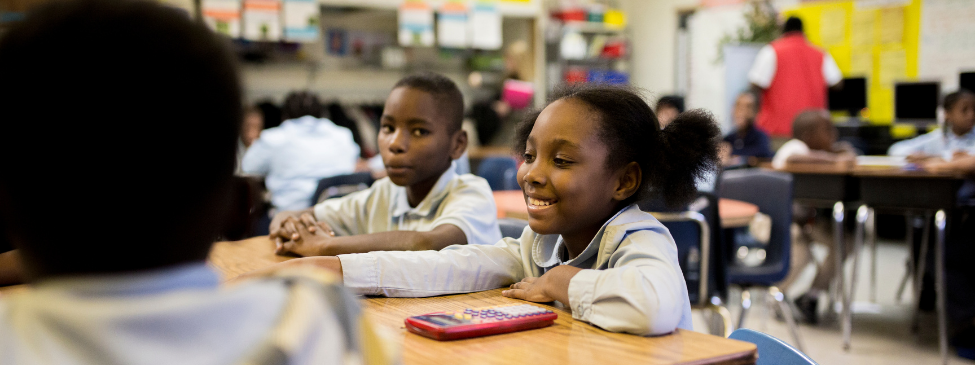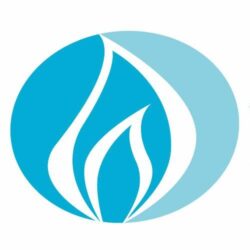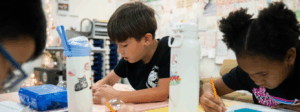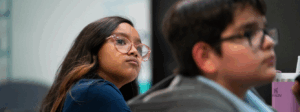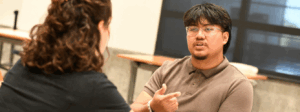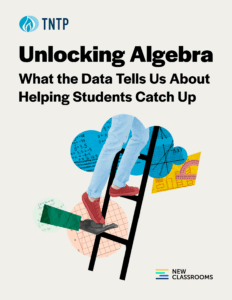Though “high-impact tutoring” (HIT)—sometimes known as “high-dosage tutoring”—has a strong research base and has been practiced for many years, it has recently garnered attention as one of the most common interventions for addressing unfinished learning from the COVID-19 pandemic. But like so many other education interventions, effective implementation of HIT isn’t easy. So what steps should school systems interested in HIT take to set themselves up for success?
One system that is thoughtfully building a promising HIT program is Uplift Education, a TNTP partner and charter school network with 45 schools and 23,000 students in and around Dallas, Texas. Uplift has had remarkable results for students: 100% of graduates have been accepted to college over the last 19 years, and they earn college degrees at four times the rate of their peers in other schools. At the same time, they are deeply committed to making students feel welcome and joyful, and are proud to have mental health counselors in all their schools.
One of the key components of HIT at Uplift is their use of “design studios”—formal structures where school leaders work with the Uplift central office to design a customized HIT program on their campuses. We spoke to Nick Erber, Director of Learning Acceleration at Uplift, about this work.
Q: Thanks for speaking to us today, Nick. First of all, can you explain what HIT is—and is not?
A: What’s important to keep in mind is that HIT is not the same as “tutoring” as most people understand it—like when a friend or relative helps a student with some tricky math homework.
In our view, HIT should have a number of key characteristics. It should be:
- Embedded in the school day—not before or after
- Three or more sessions per week
- Provided by a consistent adult to support strong relationships
- Grounded in data-driven instruction, tailored to the specific needs of students
- Integrated with what kids are learning in the classroom, focused on acceleration, not remediation
This creates a virtuous cycle: students become more confident in tutoring, and then are more successful in their regular classroom. Overall, it makes school a better place for students who are struggling.
Q: Why did you decide to incorporate design studios into Uplift’s HIT program, and how do they work?
A: Well, implementing something like HIT in 45 schools is no small feat. And since every school is different, we knew a “one-size-fits-all” model wouldn’t work—and also that we couldn’t be successful in our implementation if schools weren’t bought in. Design studios are a great way to address both of those issues. To be clear, we didn’t invent this structure. But it’s been a crucial part of our success.
We started off the design studios in our pilot schools by explaining the goals of HIT—what it is and is not, as well as an explanation of the research supporting it. It is so, so tough to be a school leader right now; there are so many things to think about besides teaching and learning. So we took the time to make the case for it and make sure everybody understood the “why.”
Something we learned early on in the process was that it is really important to try to take marginal decisions off the plates of school leaders. Our first design studios included a lot of discussion of technicalities—which are not the best use of a principal’s time, especially considering we were starting on the middle of the year. So I started doing some of the initial analysis and decision-making for them so they could focus on making choices around campus level work, which can be less visible from the central level.
It was a good reminder of something that I have found to be true throughout my career: if you show why the work matters and make it easy for people, it solves 85% of your problems.
Q: What has been the impact of the design studios on HIT at Uplift?
A: The design studios have been hugely important for the success of our HIT program. First of all, it allowed us to launch more quickly. Because of the design studios, school leaders felt more ownership and investment in the work, and also felt more comfortable taking our recommendations for logistics like vendor selection. We’ve now launched HIT in 38 schools—serving 4,000 students—in just the last two months, which is pretty remarkable.
This summer and fall, we plan to designate leaders at each campus–compensated with a stipend—to serve as “accelerated learning leads”. We hope this will allow campuses to better plan, monitor, and run data analysis on each of their programs, especially when it comes to the integration of HIT with regular classroom instruction.
Q: Anything else you’d like to share?
A: I’d just want to underscore how important it is to have a consistent adult delivering the tutoring during the sessions. Relationships are so, so important for learning, and giving our students another strong relationship with an adult at school can have positive effects far beyond the instruction itself. When done well, tutoring can support the whole student in a very real way.
